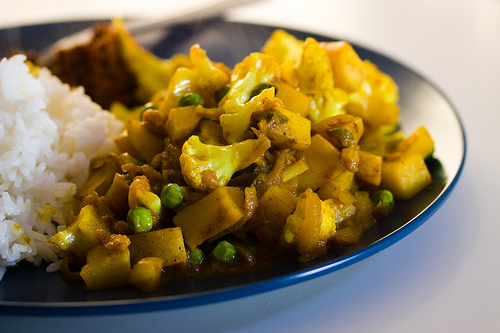
by Guest Contributor
The sight of colorful Indian dish with the smell of curry makes my mouth water. Various spices mixed together with different vegetables create a nice flavor and aroma. Indian food is not only tasty but also very healthy. The use of spices such as turmeric, ginger, onions and garlic in the dish leads to several health benefits such as lower cholesterol, reduced risk of cancer and improved liver function.
Although we know that spices and vegetables in Indian food have several health benefits, you may be surprised that Indian food is not always healthy. In this post, I will examine the benefits and disadvantages of Indian food. It is important to be aware of the pros and cons of these dishes if you are concerned about your health or just trying to lose some weight.
Benefits of Indian Food
Most of the Indian dishes are plant-based. Research shows that eating a plant-based diet has several health benefits. Some of these benefits are listed below:
Balanced Diet with Vegetarian Protein
Most Indian dishes are great balanced meals that use a wide variety of vegetables, legumes and grain. You can get complete protein from the combination of rice and lentils. Since Indian recipes use a variety of vegetables every day, you are more likely to get all the vitamins and minerals found in various plants.
The vegetables in these dishes provide several nutrients and antioxidants that are good for the heart, liver and the brain. For example, the sulfur compounds found in garlic, cauliflower and cabbage help detox your body from carcinogens and harmful toxins.
Healing Anti-Inflammatory Spices
Turmeric and other curry spices provide anti-inflammatory benefits and reduce the risk of several chronic diseases. Turmeric also provides relief from arthritis and reduces your risk of Alzheimer’s disease.
Other spices such as cardamom, cinnamon, cumin, cloves and fennel seeds reduce inflammation, increase metabolism, help lose weight and help the body detoxify. Cinnamon also helps regulate the blood sugar level.
If you like your Indian recipe to be hot and spicy, the chili is your friend not only for your taste bud but also overall health. Chilies are good sources of Vitamin C and Vitamin A. Capsaicin, which is one of the important antioxidants in chili, is effective in reducing pain and inflammation from arthritis, lowering your blood sugar level and improving blood circulation.
High Fiber Content
Since most Indian recipes use vegetables and whole grains, you will easily exceed the daily minimum fiber requirement. Chickpeas, green vegetables, rice, beans, lentils, cauliflowers, green beans, etc are great sources of both soluble and insoluble fiber.
Soluble fiber from peas, beans, carrots and legumes form a gel-like substance when dissolved in water. It plays an important role in lowering your blood cholesterol and managing your glucose levels in the blood.
Insoluble fiber from the vegetables promote bowel regularity and prevent constipation.
Ghee Health Benefits
First you may be wondering if I accidentally listed ghee under benefits. No, this is not a typo. Isn’t ghee supposed to be fattening and bad for you? Actually, ghee is healthy and it has medicinal properties if used in moderation properly.
Pure cow ghee is a staple ingredient in Indian cooking and Ayurvedic healing. Ghee is an excellent alternative to butter, processed oil and hydrogenated fat you can find in the market. The reason is the chemical structure of ghee is more stable than vegetable oil and it does not burn or turn rancid easily. The problem with most vegetable oil in the market is that the chemical structure breaks down during the heating process. They get oxidized easily and cause several problems in the body by increasing the level of free radicals.
And you probably already know how bad trans fat is for you.
On the other hand, clarified butter or ghee helps protect against the carcinogens and provides essential fatty acids for the production of hormones in the body. According to Ayurveda, ghee reduces inflammation, promotes digestion and increases metabolism.
Disadvantages of Indian Food
Although traditional Indian food is very healthy, the influence of modern civilization has made it unhealthy. If most of your experience about Indian food comes from eating at a restaurant, then you need to be aware of the disadvantages as well.
Calories from Indian Buffet
If you are at an Indian buffet and eating several plates, the overindulgence has a negative impact on your health. Most restaurants also offer several meat dishes. So instead of eating the vegetable recipes, if your choice of Indian food is mostly meat and rice, then you do not gain the full benefits of a plant-based diet listed above.
Second you need to be aware of the oil used in restaurants. Some restaurants use partially or fully hydrogenated oil instead of ghee. And be careful about MSG (monosodium glutamate) that these restaurants use to make the flavor tasty and addicting.
I have also noticed that food at Indian restaurant is more creamy that normal home-cooked Indian food. Once I asked an Indian chef to find out why the food is creamy and sweet. He mentioned that he used whipped cream to make it creamy. So you may be getting a lot of calories from extra whipped cream added to make the food flavorful.
High Sodium Content
Most Indian curry recipes use a lot of salt. Salt in moderation is beneficial. However, if the person cooking the meal has a preference for salty meals, then you may be getting more salt than your daily requirement.
If you are cooking your own Indian recipe, it is a good idea to use natural sea salt or Himalayan pink salt instead of table salt. Table salt is shown to increase hypertension, cause bloating and several undesired health problems.
Fried Appetizers
If you are eating mostly fried samosas and pakoras for Indian food, then you are getting a lot of empty calories. Research shows that deep frying destroys several essential nutrients and release potential carcinogens. If processed oil is used to fry the appetizers, the food becomes even more unhealthy.
However, the point of this article is not to scare you away from samosas. You may eat samosas in moderation but do not forget to taste the wide variety of vegetable recipes used in Indian cooking.
Sweets
Indian dishes are famous for tasty sugary sweets such as laddu and gulab jamum. Artificial processed sugar is not healthy and it will spike the glucose level and insulin in your blood. If you are trying to lose weight, keep in mind that there are several other delicious dishes that stimulate metabolism and improve your health.
In spite of these disadvantages, you can reap the positive health benefits if you know how to pick the healthiest Indian dish. If you want to add more vegetables to your diet but you always hated them, it is time to incorporate spicy curry vegetarian dish into your meal plan. Since Indian food is not bland at all, it will help you develop the fondness for veggies.
Or if you have already fallen in love with the wonderful Indian recipes, then continue to enjoy the flavor and the health benefits. At the same time, it is a good idea to remember that Indian food can be unhealthy if you do not make the right choices.






